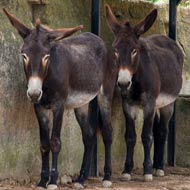
Working donkeys found to have high prevalence of health problems
New research on pain-related behaviours in working donkeys could help with the identification of painful conditions when veterinary equipment is not available.
Vets working for equine welfare charity The Brooke collaborated with researchers from the University of Bristol. They aimed to find out the prevalence of certain painful conditions in working donkeys and whether these abnormalities were linked to behavioural signs.
The research team observed 133 male adult working donkeys before they were examined by vets from The Brooke.
According to results published in the Veterinary Record, the animals had a high prevalence of clinical abnormalities; 98 per cent were lame, for example, while abnormal lung sounds were detected in 97 per cent.
"Owners and local health providers come into contact with animals affected by conditions that aren’t always easy to diagnose without equipment," explained Melissa Upjohn, research co-ordinator at The Brooke.
While abnormal lung sounds require a stethoscope and a quiet place to carry out investigations, it may be possible to visually identify conditions such as lameness, she continued.
Researchers identified a number of behaviours associated with clinical abnormalities, namely significant links between observed behaviours and systemic, ocular and limb-related problems.
Cumulative clinical scores for limb abnormalities were linked with a greater prevalence of leg trembling, forelimb knuckling, leg-lifting and weight-shifting. Limb problems were also associated with a lower frequency of even weight-bearing on all four feet.
There are an estimated 43.5 million donkeys in the world, the majority of which are working animals that support some of the world's poorest communities by transporting goods and materials by pack or cart.
Working equids risk multiple, acute and chronic health problems so recognising and assessing their pain is vital. "Spotting signs of pain and clinical problems in donkeys is always difficult as they tend to ‘suffer in silence’," explained Dr Becky Whay, from the University of Bristol.
"By carefully studying their behaviour we have started to learn how to recognise much more reliably when they are in pain and in need of attention."
To read the research, which is the final paper in a series of three, visit:
http://vetrecordopen.bmj.com/content/2/1/e000105.full



 The RCVS has announced a new version of its 1CPD mobile app, with enhanced features for veterinary surgeons and veterinary nurses to record their continuing professional development.
The RCVS has announced a new version of its 1CPD mobile app, with enhanced features for veterinary surgeons and veterinary nurses to record their continuing professional development.